英語表記の後に、日本語訳記載しています。
Introduction of me
I am a textile designer and weaver from Denmark who lives and works in Copenhagen. During my studies at the Design School and ever since I have specialised in weaving. I do artworks and research on my own manual shaft loom in my studio and I also work with digital weaving.
I have also been teaching weaving both at the design schools in Denmark and at different workshops.
In my own practice I work with textiles in a spatial context. I am interested in the effect textiles can have in interior and how it can make architecture more flexible. For that reason I have been working with things like room dividers and curtains in different ways. But I also work with an experimental approach, investigating the possibilities within weaving and what kind of objects you can create with weaving. That has led me to working with woven three dimensional objects and sculptures. For me the craft of weaving and the culture around it is also very important and I am interested in learning more about both different techniques, production methods but especially also the people working with weaving.
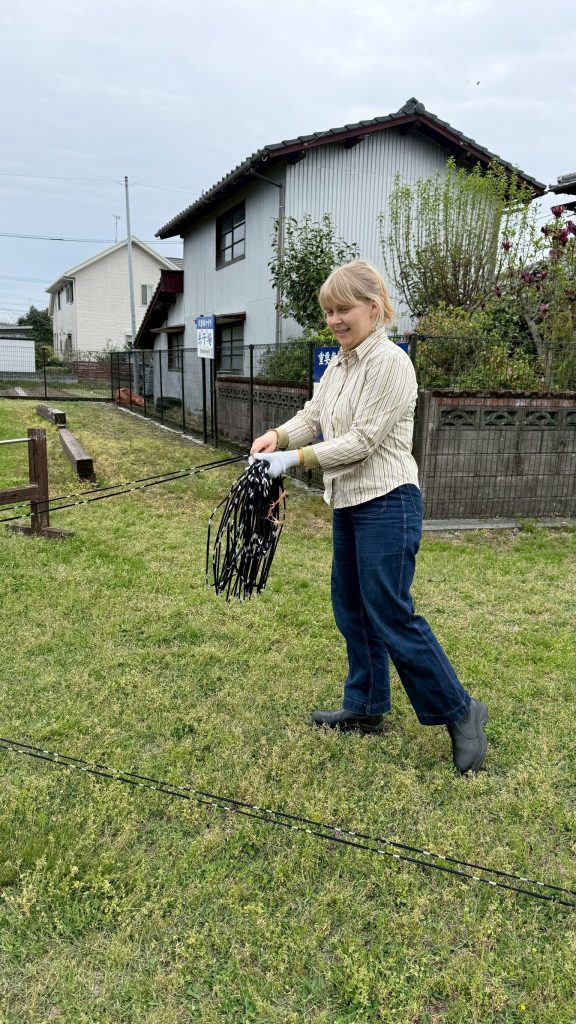
Interest in Japan
For so many years it has been a dream for me to travel to Japan because I find the culture very inspiring and of course especially the textile tradition has been fascinating to me. In Denmark we don’t have much textile production anymore because we import it, for that reason it is even more interesting for me to get an insight into the textile tradition and production in Japan. There are so many things to explore and see in Japan and for example the architecture is also very interesting to me.
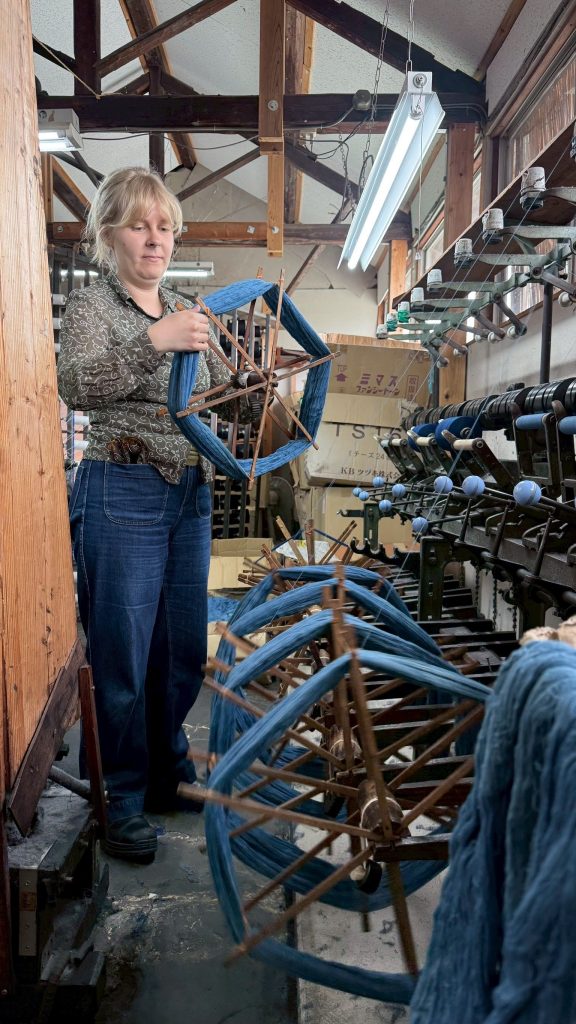
Interest in Kasuri
A couple of years ago I had the chance to travel to India to learn about ikat weaving from a master weaver in Orissa. I didn’t know much about ikat beforehand but it was a very inspiring journey for me and ever since that, I have worked with ikat weaving in various ways in my own practice. The weavers I learned from in India only did ikat by hand and they worked with very complex patterns and were specialised in double ikat (both weft and warp). It is a very time consuming technique and the people there had worked with it for many generations so they were really master craftsmen. I have tried to translate what I learned there to techniques that are possible and interesting for me to work with on my loom. I have explored different ways of working with the ikat threads and find it very fascinating how you can create patterns with this technique. The thing I love about ikat is that all throughout the process of creating it, the aim is to make the patterns precise and visible, but in the end the characteristics and quality marks of it, is the blurriness of the patterns and the impreciseness – I find that very beautiful.
Ever since I learned about ikat in India and my own further exploration of the technique I have been wanting to learn about the Japanese tradition of this technique – Kasuri.
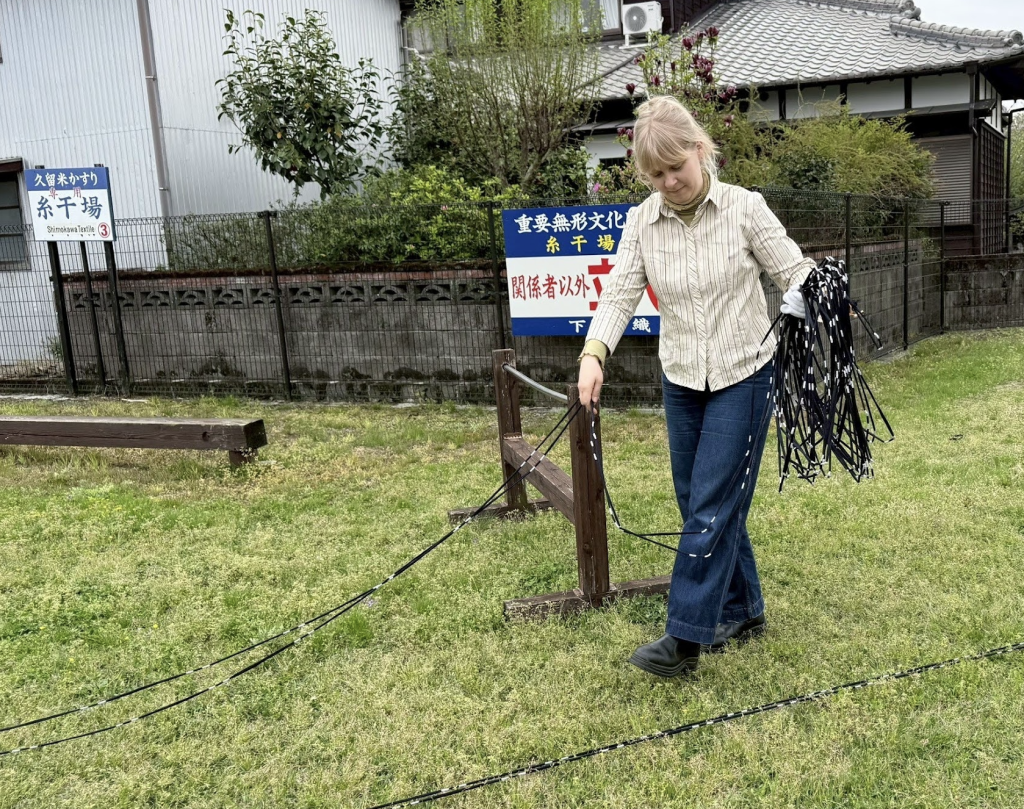
Reasons for visiting Shimogawa
I have been following Shimogawa’s work for a long time and have been very interested in their work with kasuri. Since I wanted to learn about Kasuri it seemed like a really good place to go as Kyozo Shimogawa is very open about sharing his and his employees’ knowledge about the technique. I was also especially interested to learn about how they are able to work with this technique in a bigger scale – production wise, because until now I have only learned about it in a hand weaving context. Kasuri or ikat textiles done by hand will be very expensive because the process is so time consuming and that sets limitations on the scale and context you can work with it in. I want to work with kasuri textiles in a spatial context and for that reason I need to scale up. At Shimogawa’s factory they are able to make a bigger production of kasuri textiles than when it is done by hand and still keep the high quality and the craftsmanship of the textiles.
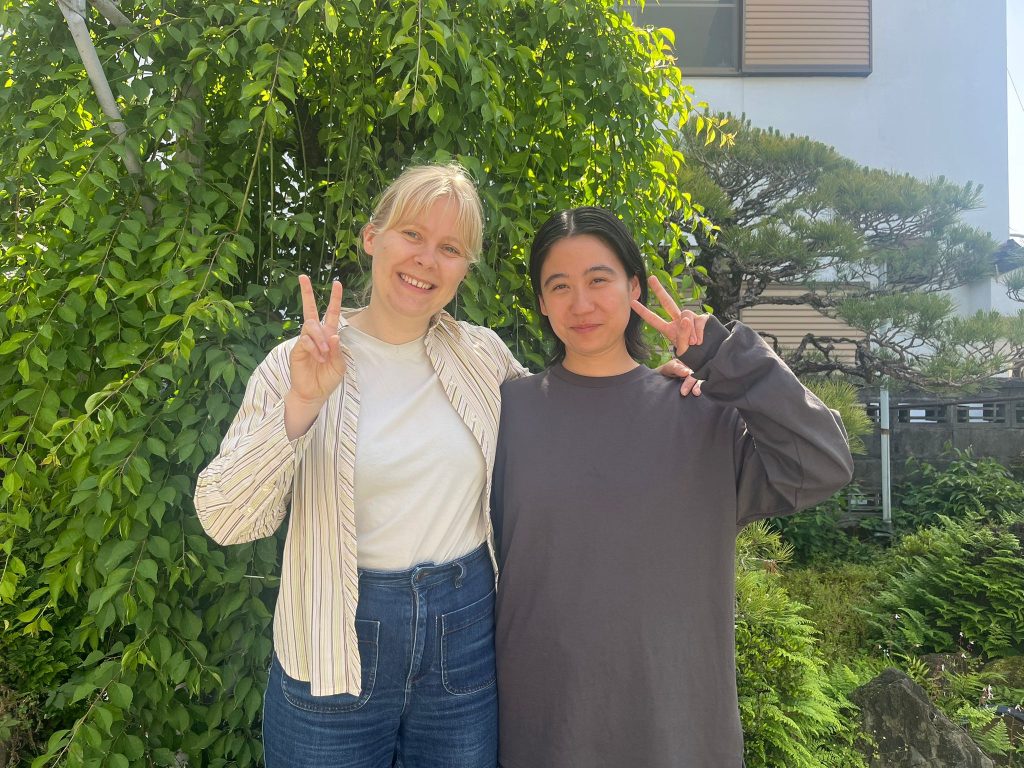
Impressions of your stay
I have learned a lot from my stay at Shimogwa’s both about kasuri, textile production, Japanese culture and life! A lot is still processing in my mind, and I am very happy to have met the people here and to follow their everyday work.
I have learned a lot about the process of weaving kasuri on machine looms and what the possibilities and limitations are, doing it in this scale of production. If I would have done a kasuri design beforehand it would have looked completely different from what I can do now with the knowledge I have gained about the process. I have looked through Shimogawas impressive archive of textiles, seen examples of a lot of different kasuri designs and collaborations they have made, which all fills me with inspiration and new ideas. Even though there really are endless possibilities in terms of design in kasuri, I find it really interesting to learn about the limitations and all the things you can think about in the design to make it more suitable for this kind of production. It is very different from weaving it by hand, as you can’t correct every thread when it is machine weaving.
I feel very privileged to have gotten this insight into Shimogawa’s work and especially to have met new friends here.
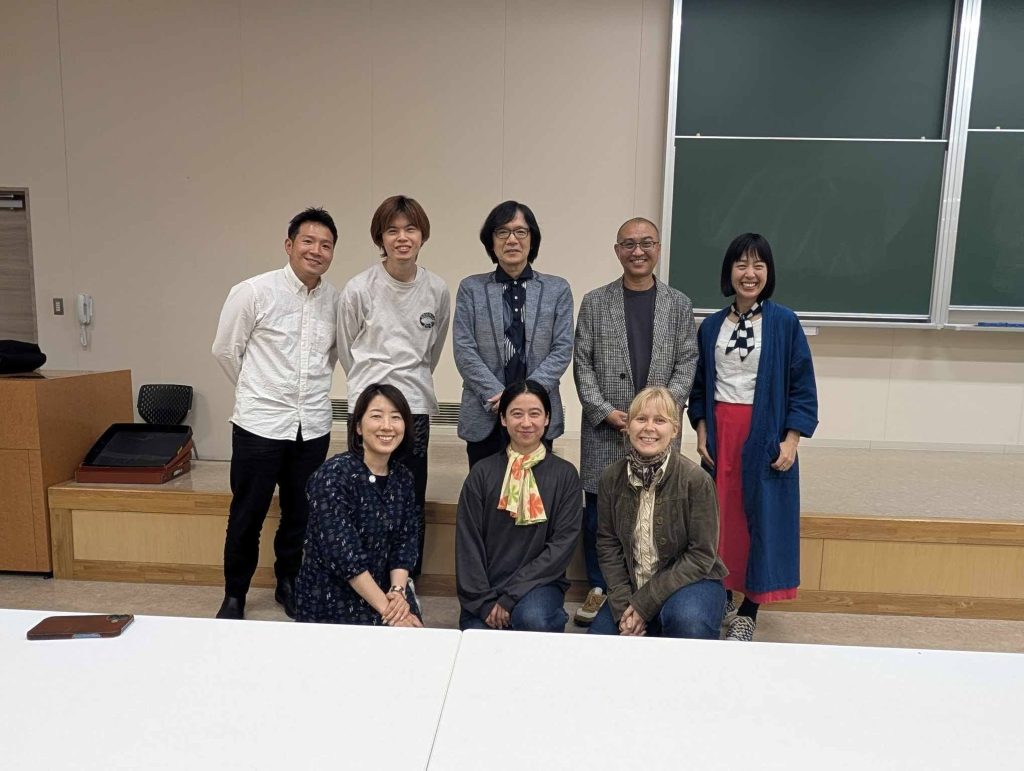
Future goals
My aim is to do a collaboration with Shimogawa to create a kasuri design. This has been my goal from the very beginning of contacting Kyozo, and now after having been here I am even more motivated to continue the process. I think kasuri textiles has so much potential in a spatial setting and I am looking forward to go back home to my studio and work on ideas and designs for this. I want to create a kasuri design that takes into consideration all these adjustments you can make to create a design that fits to the production method at Shimogawas factory and I am sure something interesting will come out of this.
I also wish to contribute to the further development of the weaving and ikat tradition and to keep these different weaving techniques alive. I am also going to continue working with ikat techniques in my own weaving practice now with new knowledge and inspiration for it.
So I hope very much to come back to Shimogawa’s kasuri village and continue the collaboration.
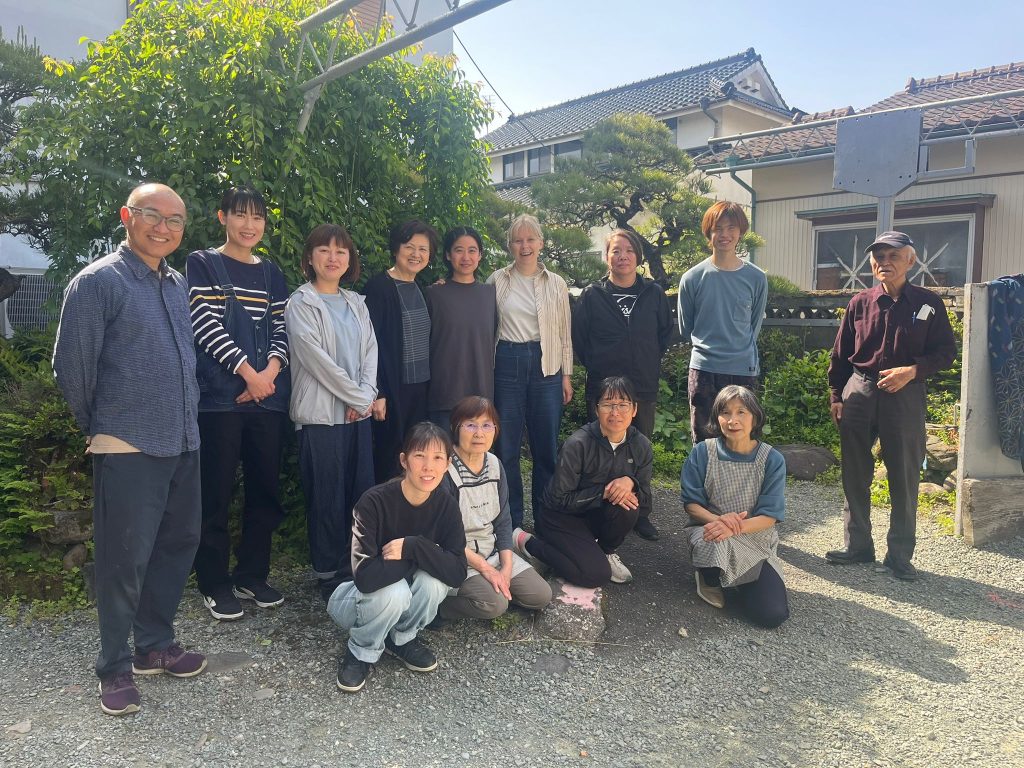
自己紹介
私はデンマーク出身のテキスタイルデザイナーおよび織物作家で、現在はコペンハーゲンに住み、活動しています。デザインスクール在学中から現在に至るまで、織りに特化してきました。自身のスタジオでは、手動のシャフト織機を用いて作品制作やリサーチを行っており、デジタル織りにも取り組んでいます。
また、デンマークのデザインスクールや様々なワークショップで織りを教えてきた経験もあります。
私自身の制作活動では、空間的な文脈におけるテキスタイルに取り組んでいます。インテリアにおけるテキスタイルの効果や、それが建築をより柔軟にする可能性に興味があります。そのため、間仕切りやカーテンなどを様々な方法で制作してきました。また、織りの中にある可能性や、織りによってどのようなオブジェクトが生み出せるのかを探求する実験的なアプローチにも取り組んでいます。これにより、三次元の織りオブジェクトや彫刻の制作にもつながっています。私にとって織りという手工芸と、それにまつわる文化は非常に重要であり、さまざまな技法や生産方法、そして何より織りに関わる人々についてもっと学びたいと考えています。
日本への関心
長年にわたって日本を訪れることが私の夢でした。日本文化に非常に刺激を受けており、特にテキスタイルの伝統には強く魅了されています。デンマークでは現在、テキスタイルの生産はほとんど行われておらず、多くは輸入に頼っています。そのため、日本におけるテキスタイルの伝統や生産に直接触れることは、私にとって非常に興味深いことです。日本には探究すべきこと、見るべきことがたくさんあり、建築にも特に興味を持っています。
絣(かすり)への関心
数年前、私はインドのオリッサ州でイカット(絣)織りをマスターウィーバーから学ぶ機会がありました。それ以前はイカットについてあまり知りませんでしたが、この旅は非常に刺激的で、それ以来、私は自分の制作の中で様々な方法でイカットに取り組んできました。インドで学んだ織り手たちはすべて手作業でイカットを行い、非常に複雑な模様を扱い、縦糸と横糸の両方を絣染めするダブルイカットの専門家でした。これは非常に時間のかかる技法で、何世代にもわたって受け継がれてきた熟練の職人によってなされています。
私はそこで学んだことを、自分の織機で可能かつ興味深い方法へと応用しようと努めてきました。イカット糸の扱い方について様々な方法を探求し、この技法で模様を生み出せることに魅了されています。イカットの魅力は、制作過程のすべての段階で模様を正確に見せることを目指すのに、最終的な特徴として模様がにじみ、不正確であることがその美しさとなる点にあると感じています。
インドでイカットを学び、さらに自分でこの技法を探求してきた経験から、私は日本の絣(Kasuri)の伝統について学びたいという思いを抱くようになりました。
下川織物を訪れた理由
私は長い間、下川織物の活動をフォローしており、彼らの絣に関する取り組みに強く興味を持ってきました。Kasuri(絣)について学びたいと思っていたため、下川恭三さんが自身と従業員の知識を惜しみなく共有されているという点で、ここはまさに訪れるべき場所だと感じました。
特に、これまで手織りの文脈でしか学んだことのなかった絣が、どのようにしてより大きな規模で(つまり生産面で)実現されているのかを学びたいと思っていました。手作業で作られた絣やイカットのテキスタイルは、その制作に非常に時間がかかるため、非常に高価になり、制作規模や使用文脈に制約が生じます。私は絣のテキスタイルを空間的な文脈で扱いたいため、スケールアップする必要があります。下川織物では、手織りに比べて大きな規模で絣のテキスタイルを生産することができ、なおかつその品質と職人技を保っている点に強く惹かれました。
滞在の印象
下川織物での滞在を通して、絣、テキスタイル生産、日本文化や日常生活について多くを学びました。まだ頭の中で整理中のことも多いですが、ここで出会った人々とその日々の仕事に触れられたことを、とても嬉しく思っています。
機械織機で絣を織る工程、その可能性と制約について多くを学びました。もし事前に絣のデザインをしていたら、それは今回得た知識をもとにした現在の理解とは全く異なるものになっていたと思います。私は下川織物の素晴らしいテキスタイルアーカイブに目を通し、様々な絣のデザインやコラボレーションの事例を見て、大きな刺激と新たなアイデアを得ました。
絣におけるデザインの可能性は本当に無限大ですが、それと同時に生産に適したデザインを考える上での制約や注意点を学ぶことも非常に興味深く感じています。手織りとは異なり、機械織りでは一本一本の糸を直すことができないためです。
下川織物の仕事に深く触れることができ、特に新たな友人たちと出会えたことを、とても光栄に思っています。
今後の目標
私の目標は、下川織物とコラボレーションし、Kasuriのデザインを制作することです。これは恭三さんに連絡を取った当初からの目標であり、今回の滞在を経てその意欲はさらに高まりました。Kasuriのテキスタイルは空間的な場面で大きな可能性を秘めていると思っており、自分のスタジオに戻って、このためのアイデアやデザインに取り組むことが楽しみです。
私は、下川織物の工場での生産方法に合った調整を加えたデザインを作りたいと考えており、きっと興味深いものが生まれると確信しています。
また、織りやイカットの伝統の更なる発展に貢献し、これらの多様な織り技術を存続させたいと願っています。今後も、自分の織りの実践の中でイカットの技法を、今回得た新たな知識とインスピレーションとともに取り入れていきたいと思っています。
ですので、再び下川織物の絣の村を訪れ、コラボレーションを続けられることを心から願っています。
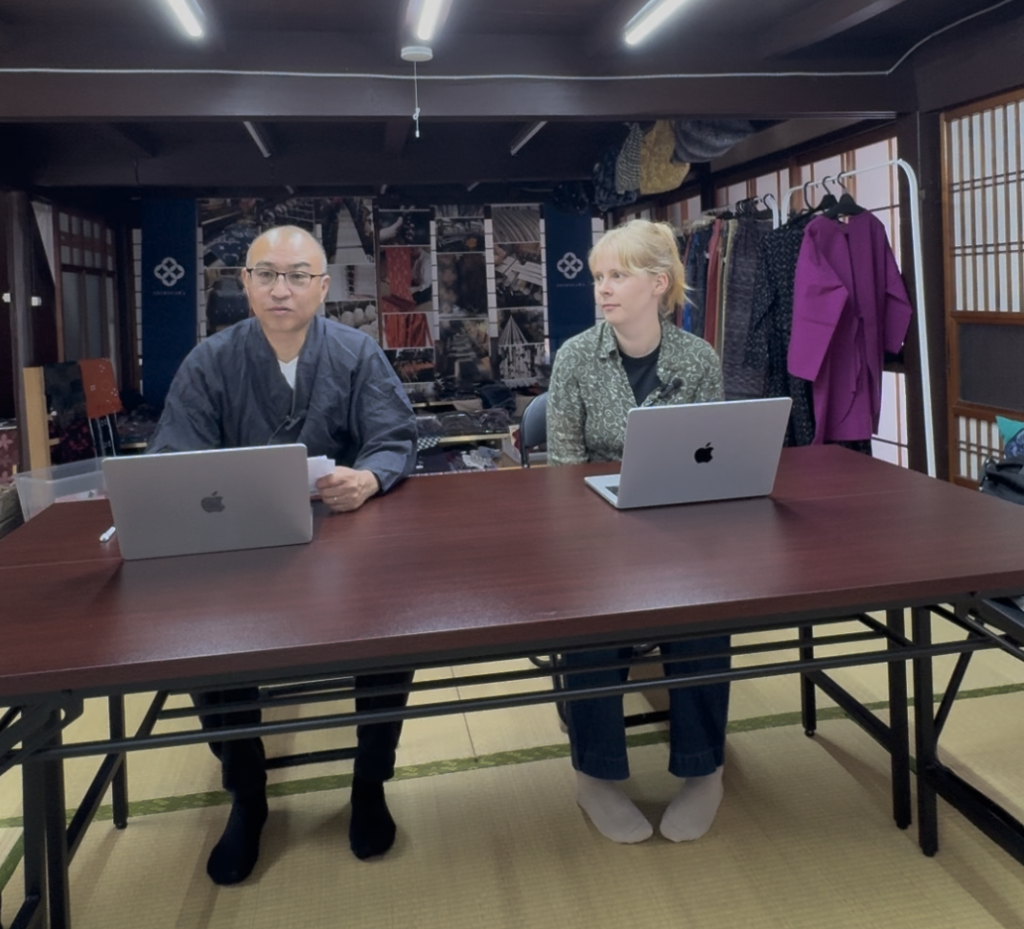
アンナ・ブルーン・クリスチャンセン さん
1年以上前から滞在希望のメッセージを送ってくれていたAnnaさんは、念願叶って下川織物訪問を果たした。初めての日本訪問が、下川織物という方は初めてではないので、だいたい共通の印象を持っている。彼女は、目的と行動に明確な目的があり自分の道をまっすぐに歩いている印象を受けた。観察して、自分の手を動かして確かめるということを繰り返すうちに当初の滞在予定だった3週間が経ち、あと1週間の延長の申し出があった。そのことで深く議論する時間も持てた。手作業で作られる絣(海外では、Ikat)は、少量生産で高価なものとなるが、久留米絣は、現代において唯一動力織機で量産できる魅力を持つ。そのことで商業ベースに生産することでいろんな可能性が広がっていく。彼女は、私のインスタグラムを数年に渡ってチェックすることでそのことに気づいた。発見→滞在→学び→コラボ制作という循環を作ることで、世界中にビジネスパートナーを作り続ける。独自のコミュニティを形成することで、絣を作り続ける。下川織物として、正式にインターンシップ制度を確立して、公式に募集する時期が来たと確信した。
久留米絣織元 下川織物
E-MAIL info@oriyasan.com
instagram https://www.instagram.com/shimogawakyozo/
facebook https://www.facebook.com/shimogawaorimono
YouTube https://www.youtube.com/channel/UCOZennIqkscFGNJLwnTOyKg